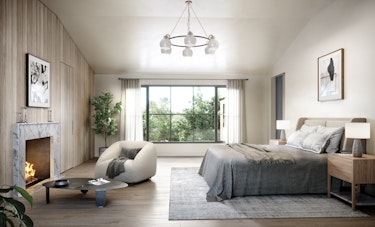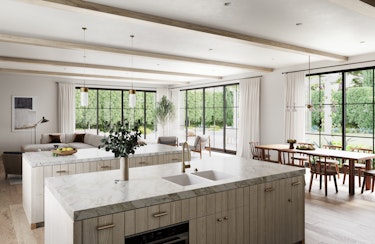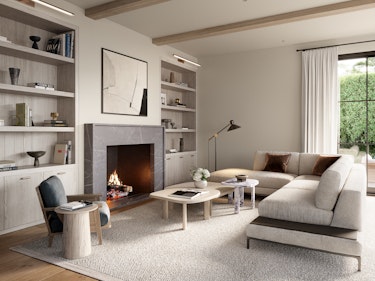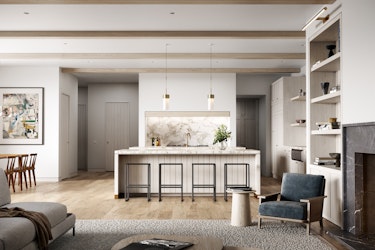Interior renderings can be an effective tool for selling the intricacies of a building's design. For architects, they're the finishing touch on tens of thousands of hours of design labor. They are the lifeblood of an interior designer's business, and they must be of the highest quality if they wish to accomplish the best job and attract the most prestigious clientele.
However, getting them just right isn't always easy. When it comes to lighting, scale, and materiality, there's a lot less flexibility with 3D interior design renders. Exterior renderings have a larger margin of error because there is no risk of the picture becoming claustrophobic or distorted. Interior renderings, on the other hand, can be challenging to represent precisely how a human will experience it.
This blog will focus on a few key factors to remember when it comes to making the most of your 3D interior design.

Start Referencing
Having a realistic reference will always make the process easier, whether we're talking about different spaces or you're recreating 3D, finishes, or light sources.
Without appropriate references, it's easy to ignore some of the key elements of the things you're rendering in 3D interior design renders, no matter how creative you are. It's well known that having solid references at the start of a project can have a serious influence on the image quality. Photographic references will simplify your life by assimilating your eyes into the way things work in nature.
By studying your real-life reference, you'll understand more about the texture and material, and you'll be able to generate a far more appealing and photorealistic 3D architectural visualization. Of course, your 3D interior design render doesn't have to be an exact reproduction of the reference; it's only a tool to aid in the creation of a more realistic 3D interior design.
Play with Lighting
One of the most important aspects of any 3D interior design is lighting. It brings textures to life and gives the environment a one-of-a-kind vibe. Lighting can assist you in making your designs stand out. This is why you should avoid becoming a law-abiding designer that only uses natural lighting.
What are your alternatives? Aside from employing windows as natural light sources, you should also use spotlights and directed lighting in your interior visualization. Spotlights are fantastic for shadows and can give the scene that vibrant feel. On the other hand, if you want to draw attention to something in your scene, directional lighting is a fantastic approach to achieve so.
Every render requires lighting, which is crucial to the interior design of a space. It creates a mood, directs the viewer's gaze, and draws attention to textural elements across the image.

Textures can help elevate your concept
Aside from lighting, high-quality textures are another crucial component of a great 3D interior design. If you truly want your scene to have a realistic feel, you must use actual materials and textures. You'll need high-quality textures to achieve this in high-quality 3D interior renders.
Make sure to modify your textures before leaving your design. Gloss and reflectivity are vital, but you should also consider your materials' roughness. This is especially critical if your setting includes wood, metal, and stone.
Create Scale Through Activity
Plenty of interior 3D interior renderings suffers from a sterile quality or scale and movement because they don’t have actual people in them. Because buildings are rarely used in that manner, your 3D interior rendering of such spaces must be vibrant to best engage them and make them feel worthwhile to visit.
Laughing children are great. Even better are people playing with their pets on a green stretch of land. The goal is to depict happy individuals doing pleasant things so that the viewer does not have to rely on their imagination to fill in the blanks.
The Colours Sum It Up
If you want to produce a realistic 3D interior design graphic, you must choose your color palette carefully. You can choose from millions of stunning colors, each one more impactful than the last. Sticking to natural material hues, on the other hand, is usually the greatest option. This isn't to say that you have to stick to earthy tones and simply utilize browns and beige (the choices of color depend entirely on your preference, and that of your client).
Colors and their properties can also be employed to direct the viewer's attention and create focal points. It simply implies that you should avoid very saturated hues as well as those that are totally black or white. It's easy to get carried away when working with a variety of colors and textures. However, think about how the colors you choose will work together and whether they are appropriate for the room. When looking at a 3D interior design render, a poorly thought-out color palette can make you feel uneasy.
When you have vivid red or powerful magenta as blasts of color, the chromatic aberration effect can help them stick out even more. Colour fringing (or distortion) is common in real-life photographs, and it can be a great accent to any 3D interior design photograph.

These five suggestions will assist you in prioritizing your workflow for the 3D interior design and making it more efficient. It's also necessary to master the lighting and texturing, but it's not as difficult as it appears. Finally, don't forget to experiment with camera angles to acquire the best views of your 3D interior visualizations.
The better (and less expensive) alternative is to carefully choose one or two notable views that best showcase the design. These are known as money shots,' and they are a targeted picture of the design execution that includes all of the best elements. Edit your 3D interior rendering method and ensure that the result your clients see is your best work.
